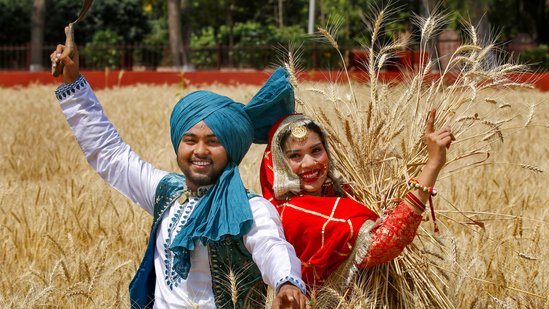Baisakhi Festival
Baisakhi, the centuries-old festival celebrated on April 13 (and occasionally on April 14), is being observed with enthusiasm across Punjab today, marking the beginning of the wheat harvest.
This agrarian celebration is one of the most significant cultural events for the rural population of Punjab, with deep roots in both agricultural and religious traditions.
Traditionally, Baisakhi represents the end of months of vigilant crop-watching and signals the commencement of harvesting the fruits of the farmers’ labor. For the farming community, it is perhaps the most joyous day of the year, as it marks the moment when their hard work transforms into tangible rewards.
Prior to the Partition of India, Baisakhi was a vibrant and lively festival. It was celebrated with communal activities where farmers gathered to the rhythm of drums, signaling the start of the harvest season.
Women sang traditional folk songs, known as tapay and mahiye, while men and boys performed energetic bhangra dances, infusing the fields with life and energy.
However, with the advent of mechanization, including combine harvesters and threshers, the traditional communal harvest practices have changed, and the vibrancy of the festival has been diminished.
Today, although the mechanized harvest process has altered the customs, Baisakhi still holds significant cultural importance, especially in rural areas.
Besides its agricultural relevance, Baisakhi also has profound religious significance for Sikhs, as it commemorates the founding of the Khalsa by Guru Gobind Singh in 1699.
After the Partition, the festival became more closely tied to Sikhism, and it is now celebrated with a special ceremony held at Gurdwara Panja Sahib in Hasan Abdal. This year, the central celebrations will be hosted at Gurdwara Janam Asthan in Nankana Sahib, the birthplace of Guru Nanak.
As part of the festivities, thousands of Sikh pilgrims from India are visiting Pakistan to take part in the Baisakhi celebrations.
The Pakistani High Commission in New Delhi has issued over 6,500 visas to Indian pilgrims, enabling them to visit several revered gurdwaras in Pakistan, including Gurdwara Panja Sahib, Gurdwara Kartarpur Sahib, and Gurdwara Nankana Sahib.
This initiative is part of the Pakistan-India Protocol on Visits to Religious Shrines of 1974, which facilitates cross-border travel for religious purposes.
Charge d’Affaires Saad Ahmad Warraich emphasized that the large number of visas issued is a reflection of Pakistan’s commitment to fostering harmony and understanding between the peoples, cultures, and religions of both countries.
He assured that Pakistan would continue facilitating visits to sacred sites, promoting peace and unity through shared religious and cultural experiences.










